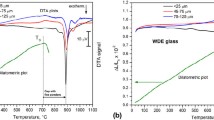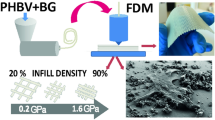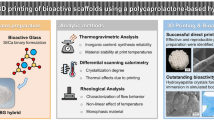Abstract
This paper reports a study on the development of bioactive glass powders for biofabrication of scaffolds by an additive manufacturing technique, three-dimensional printing (3DP). Several formulations of the glass were developed from the CaO·P2O5·TiO2 system and prepared on the basis of the results for the commercial powder characterization (average particle size, particle size distribution, microstructural and crystallographic analysis). For printing the glass models in the prototyping machine, a virtual model defined as the “standard model” was produced in commercial powder, and a systematic study of the relevant processing parameters (binder composition, formulation of powder, saturation level in the shell and core, bleed compensation, and printed layer thickness) was carried out in order to determine the most suitable conditions for the fabrication of porous structures for tissue engineering applications. The printed glass models were sintered through specific thermal programs and then characterized in terms of dimensions, structure, morphological features, and mechanical properties. Finally, the sintered models were submitted to mineralization tests in simulated physiological media. In this work, it was demonstrated that it is possible to use a printing machine to manufacture 3DP glassy porous structures with suitable features for tissue engineering applications as temporary scaffolds. The mechanical properties of the produced structures and its mineralization capability in physiological fluids suggest that they have potential to be used in bone tissue regeneration under low load-bearing situations.
Similar content being viewed by others
References
Butscher A, Bohner M, Hofmann S et al (2011) Structural and material approaches to bone tissue engineering in powder-based three-dimensional printing. Acta Biomater 7:907–920. https://doi.org/10.1016/j.actbio.2010.09.039
Best SM, Porter AE, Thian ES, Huang J (2008) Bioceramics: past, present and for the future. J Eur Ceram Soc 28:1319–1327. https://doi.org/10.1016/j.jeurceramsoc.2007.12.001
Derby B (2012) Printing and prototyping of tissues and scaffolds. Science 338:921–926. https://doi.org/10.1126/science.1226340
Salgado AJ, Coutinho OP, Reis RL (2004) Bone tissue engineering: state of the art and future trends. Macromol Biosci 4:743–765
Yeong W-Y, Chua C-K, Leong K-F, Chandrasekaran M (2004) Rapid prototyping in tissue engineering: challenges and potential. Trends Biotechnol 22:643–652. https://doi.org/10.1016/j.tibtech.2004.10.004
Melchels FPW, Domingos MAN, Klein TJ et al (2012) Additive manufacturing of tissues and organs. Prog Polym Sci 37:1079–1104
Hench L (2006) The story of bioglass®. J Mater Sci Mater Med 17:967–978. https://doi.org/10.1007/s10856-006-0432-z
Silva AMB, Correia RN, Oliveira JMM, Fernandes MHVJ (2010) Structural characterization of TiO2-P2O5-CaO glasses by spectroscopy. J Eur Ceram Soc 30:1253–1258
Sobral JM, Caridade SG, Sousa RA et al (2011) Three-dimensional plotted scaffolds with controlled pore size gradients: effect of scaffold geometry on mechanical performance and cell seeding efficiency. Acta Biomater 7:1009–1018. https://doi.org/10.1016/j.actbio.2010.11.003
Farzadi A, Waran V, Solati-Hashjin M et al (2015) Effect of layer printing delay on mechanical properties and dimensional accuracy of 3D printed porous prototypes in bone tissue engineering. Ceram Int 41:8320–8330. https://doi.org/10.1016/j.ceramint.2015.03.004
Bose S, Vahabzadeh S, Bandyopadhyay A (2013) Bone tissue engineering using 3D printing. Mater Today 16:496–504. https://doi.org/10.1016/j.mattod.2013.11.017
Hutmacher DW, Sittinger M, Risbud MV (2004) Scaffold-based tissue engineering: rationale for computer-aided design and solid free-form fabrication systems. Trends Biotechnol 22:354–362. https://doi.org/10.1016/j.tibtech.2004.05.005
Leukers B, Gulkan H, Irsen SH et al (2005) Hydroxyapatite scaffolds for bone tissue engineering made by 3D printing. J Mater Sci Med 16:1121–1124. https://doi.org/10.1007/s10856-005-4716-5
Leong KF, Cheah CM, Chua CK (2003) Solid freeform fabrication of three-dimensional scaffolds for engineering replacement tissues and organs. Biomaterials 24:2363–2378. https://doi.org/10.1016/s0142-9612(03)00030-9
Butscher A (2013) Powder based three-dimensional printing of calcium phosphate structures for scaffold engineering. ETH ZURICH
Zocca A (2015) Additive manufacturing of porous ceramic structures from preceramic polymers. University of Padova
Miguel C, Barbara G, Inês P et al (2015) The role of shell/core saturation level on the accuracy and mechanical characteristics of porous calcium phosphate models produced by 3D printingnull. Rapid Prototyp J 21:43–55. https://doi.org/10.1108/RPJ-02-2013-0015
Bergmann C, Lindner M, Zhang W et al (2010) 3D printing of bone substitute implants using calcium phosphate and bioactive glasses. J Eur Ceram Soc 30:2563–2567. https://doi.org/10.1016/j.jeurceramsoc.2010.04.037
Fu Q, Saiz E, Rahaman MN, Tomsia AP (2011) Bioactive glass scaffolds for bone tissue engineering: state of the art and future perspectives. Mater Sci Eng C 31:1245–1256. https://doi.org/10.1016/j.msec.2011.04.022
Suwanprateeb J, Sanngam R, Suvannapruk W, Panyathanmaporn T (2009) Mechanical and in vitro performance of apatite–wollastonite glass ceramic reinforced hydroxyapatite composite fabricated by 3D-printing. J Mater Sci Mater Med 20:1281–1289. https://doi.org/10.1007/s10856-009-3697-1
Kokubo T, Takadama H (2006) How useful is SBF in predicting in vivo bone bioactivity? Biomaterials 27:2907–2915. https://doi.org/10.1016/j.biomaterials.2006.01.017
Utela B, Storti D, Anderson R, Ganter M (2008) A review of process development steps for new material systems in three dimensional printing (3DP). J Manuf Process 10:96–104. https://doi.org/10.1016/j.jmapro.2009.03.002
Kuznetsova DS, Timashev PS, Bagratashvili VN, Zagaynova EV (2014) Scaffold- and cell system-based bone grafts in tissue engineering (review). Sovrem Tehnol v Med 6:201–211
Suwanprateeb J, Kerdsook S, Boonsiri T, Pratumpong P (2011) Evaluation of heat treatment regimes and their influences on the properties of powder-printed high-density polyethylene bone implant. Polym Int 60:758–764. https://doi.org/10.1002/pi.3006
Suwanprateeb J, Chumnanklang R (2006) Three-dimensional printing of porous polyethylene structure using water-based binders. J Biomed Mater Res Part B Appl Biomater 78B:138–145
Tay B, Zhang S, Myint M et al (2007) Processing of polycaprolactone porous structure for scaffold development. J Mater Process Technol 182:117–121. https://doi.org/10.1016/j.jmatprotec.2006.07.016
Butscher A, Bohner M, Roth C et al (2011) Printability of calcium phosphate powders for three-dimensional printing of tissue engineering scaffolds. Acta Biomater. https://doi.org/10.1016/j.actbio.2011.08.027
Yao AWL, Tseng YC (2002) A robust process optimization for a powder type rapid prototyper. Rapid Prototyp J 8:180–189. https://doi.org/10.1108/13552540210431004
Udroiu R Rapid tooling by three dimensional printing (3DP). Recent Res Manuf Eng 177–180
Vaezi M, Chua CK (2011) Effects of layer thickness and binder saturation level parameters on 3D printing process. Int J Adv Manuf Technol 53:275–284
Stopp S, Wolff T, Irlinger F, Lueth T (2008) A new method for printer calibration and contour accuracy manufacturing with 3D-print technology. Rapid Prototyp J 14:167–172. https://doi.org/10.1108/13552540810878030
Hsu T-J, Lai W-H (2010) Manufacturing parts optimization in the three-dimensional printing process by the Taguchi method. J Chinese Inst Eng 33:121–130. https://doi.org/10.1080/02533839.2010.9671604
Jee HJ, Sachs E (2000) A visual simulation technique for 3D printing. Adv Eng Softw 31:97–106. https://doi.org/10.1016/s0965-9978(99)00045-9
Kishioka A (1978) Glass formation in the Li2O-TiO2-P2O5, MgO-TiO2-P2O5, and CaO-TiO2-P2O5 systems. Bull Chem Soc Jpn 51(9):2559–2561
Kishioka A, Haba M, Amagasa M (1974) Glass formation in multicomponent phosphate systems containing TiO2. Bull Chem Soc Jpn 47(10):2493–2496
Szűcs TD (2008) Production of hard tissue scaffolds using three-dimensional printing method. Dublin city University
Marshall J (2009) Personal Prototyping: Ceramics-based 3D inkjet and laser printing technology offers customized tissue engineering, body parts and more. Am Ceram Soc Bull 88:19–25
Acknowledgements
This work was developed within the scope of the project CICECO-Aveiro Institute of Materials, POCI-01-0145-FEDER-007679 (FCT Ref. UID/CTM/50011/2013), financed by national funds through the FCT/MEC and when appropriate cofinanced by FEDER under the PT2020 Partnership Agreement.
The authors are indebted to Professor Artur Mateus and Margarida Franco from Centre for Rapid and Sustainable Product Development of Polytechnic Institute of Leiria for micro CT characterization.
Author information
Authors and Affiliations
Corresponding author
Rights and permissions
About this article
Cite this article
Pires, L.S.O., Fernandes, M.H.F.V. & de Oliveira, J.M.M. Biofabrication of glass scaffolds by 3D printing for tissue engineering. Int J Adv Manuf Technol 98, 2665–2676 (2018). https://doi.org/10.1007/s00170-018-2369-z
Received:
Accepted:
Published:
Issue Date:
DOI: https://doi.org/10.1007/s00170-018-2369-z




